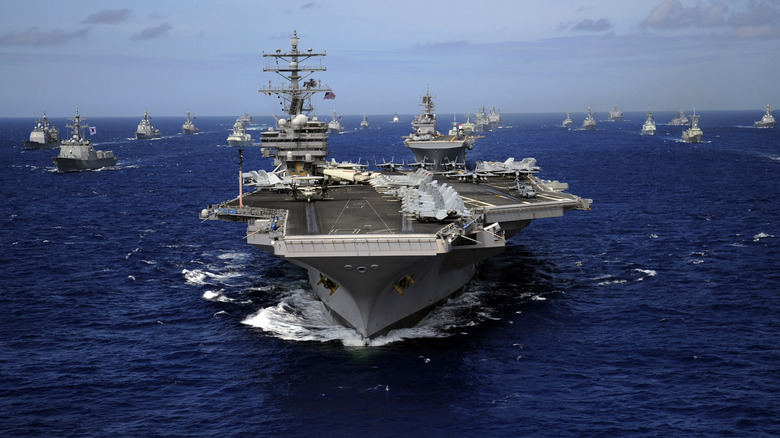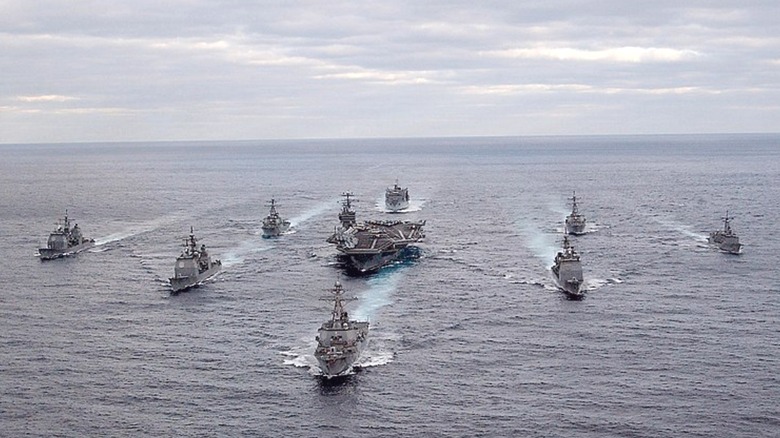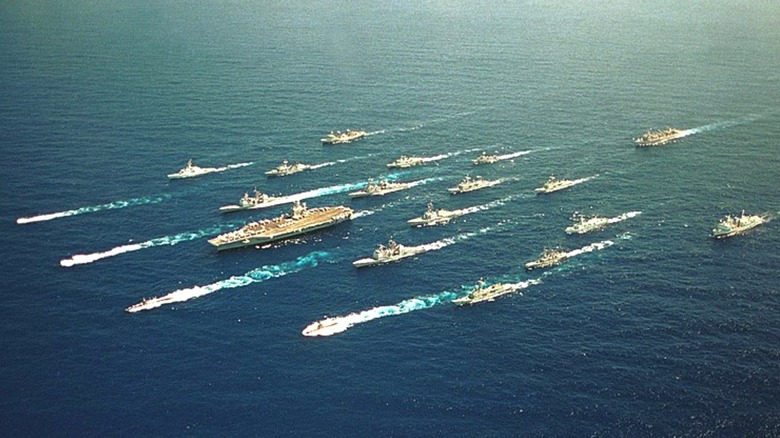How Many Ships Are In A Carrier Strike Group? (And What Types Of Ships Are They?)
Most people know that the United States has several aircraft carriers, but what isn't as well known is how they operate. Aircraft carriers are some of the largest and most powerful military vehicles ever created, and they typically house some 5,000+ personnel. They also maintain a fleet of aircraft, watercraft, and more in their various missions, but they don't operate in a vacuum.
When a carrier deploys, it does so as the lead vessel in what's called a Carrier Strike Group (CSG) or Carrier Battle Group (CVBG). These are large flotillas of naval vessels that include all kinds of ships. Some are there for direct support, while others are there for defense and offensive capabilities. A Carrier Strike Group typically consists of various types of cruisers, anti-aircraft surface vessels, anti-submarine destroyers, and frigates. Sometimes, a submarine is thrown into the mix, so a U.S. CSG is a powerful element of naval offensive and defensive capabilities.
As of mid-2024, the U.S. Navy operates 11 carriers, and they each have a strike group associated with them. According to the Navy, a "CSG or CVBG normally consist of 1 Aircraft Carrier, 2 Guided Missile Cruisers, 2 Anti Aircraft Warships,and 1-2 Anti Submarine Destroyers or Frigates," for a total of eight ships. Of course, these configurations change all the time and often cater to their designated missions, so a CSG or CVBG's makeup isn't always the same.
An example of a CSG
Every carrier has its own CSG or CVBG, but they don't always work with the same vessels. A group's makeup can change as ships return to port for crew relief, maintenance, or a myriad of reasons, but they typically are replaced with vessels of the same type. Carrier Strike Group 3 was associated with the USS Abraham Lincoln (CVN 72) and its support ships. These included the since-decommissioned USS Mobile Bay (CG-53) and Destroyer Squadron 21.
Destroyer Squadron 21 consists of the USS Milius (DDG 69), the USS Decatur (DDG 73), the USS Kidd (DDG 100), the USS Dewey (DDG 105), and the USS Wayne E. Meyer (DDG 108). Each of these ships provides a different level of support ranging from a variety of missile offensive and defensive capabilities. Destroyers come in different configurations, and Destroyer Squadron 21 is outfitted with guided-missile destroyers.
A guided-missile destroyer is used to provide anti-aircraft defenses for the fleet, but they also provide offensive capabilities, depending on the type of munitions in their stores. In terms of personnel, the Navy keeps its exact numbers classified, but it's possible to determine an estimate based on the standard complement for the vessels in a CSG. Conservatively, CVN-72 houses 5,000 personnel, while an Arleigh Burke-class guided-missile cruiser houses around 300-360 crew. Put them all together and a typical CSG consists of some 7,500 sailors.
Other possible CSG and CVBG configurations
While it's not unusual to have a host of destroyers accompanying an aircraft carrier, that's not the only type of vessel found in a CSG. A CSG can also include a replenishment ship, a cruiser, and a submarine. On top of the naval vessels within a CSG, there are also numerous aircraft. A modern aircraft carrier can hold a variety of vehicles, including all manner of fighters, bombers, transport aircraft, helicopters, and drones.
There's a variety of possibilities in terms of what aircraft can take off and land on a carrier. Currently, the U.S. operates two classes of carriers, the Nimitz and Gerald R. Ford-class ships. The latter is the newest, and they carry around 75 aircraft, including the F-18 Super Hornet and the E-2 Hawkeye. The older Nimitz-class carriers typically accommodate up to 60 aircraft. All this together makes up a large military force capable of striking targets anywhere in the world.
The U.S. maintains ten CSGs in the United States and one in Japan. Each is ordered to a particular area for a set period, where they carry out a variety of missions in support of U.S. interests abroad. Because a CSG can also include amphibious assault ships loaded with Marines, they present a lethal force that can engage targets on both land, in the air, and at sea. While a carrier could do many of these missions alone, they remain protected and fully mission-capable, thanks to their support ships.


